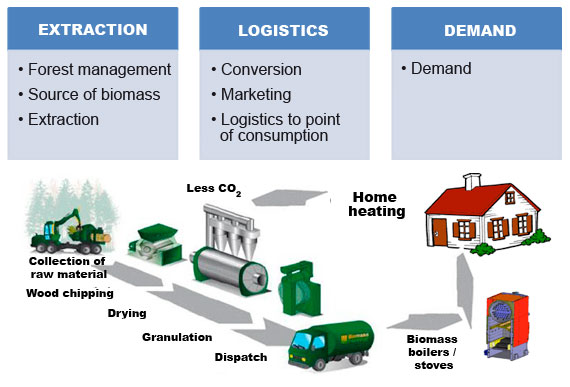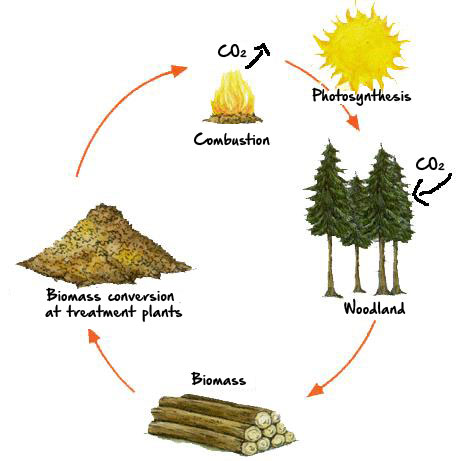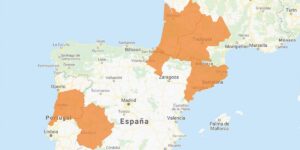FREQUENTLY ASKED QUESTIONS
What is Biomass?
Biomass is an organic material sourced from plants or animals, including organic waste and scraps, that can be used to generate electricity. Plants convert the radiant energy from the sun into chemical energy through photosynthesis, and part of this energy is stored in the form of organic matter.
What is the Biomass cycle?
The biomass cycle includes three phases:

The biomass energy comes from the sun. Plants use the solar energy for photosynthesis. In this process, the plants take carbon dioxide (CO2) and convert it into oxygen (O2). During the combustion of plant biomass, carbon dioxide CO2 is released, which is absorbed by the plants and the biomass biological cycle starts over again.
What types of biomass exist?
Biomass can be classed into three main types:
- Natural, generated by nature with no human intervention.
- Waste, comprising solid waste (dry biomass) or biodegradable effluent (wet biomass)
- Produced. These are the energy crops that are solely made for producing biomass that can be converted into fuel.
How is biomass used?
Biomass can be used to produce thermal, electrical and mechanical energy. The methods used for the production of this energy can, broadly speaking, be thermochemical and biochemical. Among the former, particular mention should be made of combustion and gasification, and, among the latter, anaerobic digestion. The use of one method or another depends on the type of fuel, the demand and its application
Systems based on combustion
The biomass is burned at high temperatures (from 600 to 1,300 ºC) and in the presence of large amounts of air. The energy obtained may be used for the production of heat (in the form of water or hot air) for domestic or industrial use, and for the production of electricity.
Systems based on gasification
The biomass is decomposed by heat to give a combustible gas, with similar applications to those of natural gas.
Anaerobic digestion
The absence of oxygen leads to the degradation of the organic matter by the action of some specific micro-organisms, that convert it into biogas and into other products called sludge. Biogas can be used to produce electrical or thermal energy, or to generate both types of energy through cogeneration systems.
What are the certifications and what types of certification exist?
As the use of biomass has increased, quality standards have been progressively developed to ensure, in some cases, correct forest management and, in others, the marketing of a product of verifiable quality.
Standards ISO/UNE
ISO 17225: at an international level ISO (International Standards Organisation) has developed a series of quality assurance standards (8) affecting the solid biofuels that are most used at an international level, such as pellets, wood chips and wood.
UNE 164003 and UNE 164004: moreover, in Spain, and in order to take into consideration the solid biofuels that are characteristic to the Spanish market AENOR (Spanish Association of Standardisation and Certification) has developed quality standards relating to olive stones and nut shells.
Certification ENplus®
This is a certification system based on the international standard ISO 17225-2, referring exclusively to wood pellets for non-industrial uses. These are classified into three qualities:
- A1 (pellets made from chemically untreated virgin wood and wood residues, with low ash, nitrogen and chlorine content)
- A2 (fuels with a slightly higher ash, nitrogen and/or chlorine content)
- B (Pellets made from recycled wood and industrial waste wood). Values for heavy metal content are also included.
The rights fro the ENplus® mark are held by the European Pellet Council. AVEBIOM is the licensee responsible for the management of the system in Spain.
Certification BIOmasud®
This is a private quality and sustainability certification system that is the fruit of a European project bearing the same name and financed with ERDF funds within the framework of the Interreg IV-B program. It is a certification system for Mediterranean biofuels: wood pellets, olive stones, wood chips and dried fruit shells. For wood pellets and chips, the system is based on international standards ISO 17225-2 for wood pellets and 17225-4 for chips, while, for the other biofuels, it is based on own pre-standards developed during the project.
Apart from the quality, the system also has sustainability requirements such as the carbon footprint or the energy used to produce the biofuel. The rights for the BIOmasud® mark in Spain are held by AVEBIOM and CIEMAT.
FSC Forest Management Certification
FSC (Forest Stewardship Council) is a not-for-profit organization that sets the standards for what is a responsibly managed forest, both environmentally and socially. FSC has national offices in a number of countries: FSC Spain, France and Portugal, among others.
FSC label – Forest Stewardship Council
Certification was created by an international NGO in 1993. It can be obtained by:
- Owners, with regard to financial management.
- Processing companies, for product traceability.
The certification procedures are linked to a list of 11 principles that must be observed, relating to three aspects (financial, social and environmental).
Certification is granted for a period of 5 years with at least one annual audit: these inspections may lead to withdrawal, suspension or the obligation to make corrections.
The two special characteristics of FSC certification are:
- The use of the logo on the company’s products and documents (invoices),
- Group certification (under certain conditions). For example: the construction of buildings in a wood.
At the end of 2010, in France there were 18,000 hectares of woodlands with FSC certification.
An online database allows users to search by country: FSC: database access For further information: https://www.fsc.org/
PEFC (Pan European Forest Certification) – European Forest Certification Programme
It was founded in July 1998, on the initiative of forest owners from six European countries. PEFC France participates in the management of the PEFC mark and issues the authorisations for use. The PEFC mark guarantees that the wood is sourced from sustainably managed forests based on precisely established rules, region by region.
In France, more than 8 million hectares of forest have the PEFC certificate and more than 3,000 companies use the wood and products generated in 14 different business sectors. The list of certified companies can be consulted online.
In January 2012, PEFC France launched a new system with a five year duration. The changes affect:
- The alignment of the sustainable forest management criteria (just one specifications document for owners, compared to the 15 formerly required).
- an increase in the quantified demands and in the control audits of members.
- greater support at a national and local level (creation of a national technical committee of experts and support from the end of 2011 onwards).
For more information::
Learn more about the newPEFC certification system
PEFC
Source: Instituto para la Diversificación y ahorro de la Energía (IDAE) y FSC España.







